Raymond Moriyama
| Raymond Moriyama CC OOnt | |
|---|---|
| Born |
October 11, 1929 Vancouver, British Columbia, Canada |
| Nationality | Canadian |
| Occupation | Architect |
| Awards | Governor General's Award in Visual and Media Arts |
| Practice | Moriyama & Teshima Architects |
Raymond Moriyama CC OOnt (born October 11, 1929)[1] is a Canadian architect.
Of Japanese descent, Moriyama with his family was forced out of Vancouver and confined to an internment camp during World War II. He has said that these years have particularly informed his later career.
Early life and education
Born in Vancouver, British Columbia, Raymond Moriyama suffered burns as a four-year-old and was sometimes teased about his scars. During the eight months he spent bedridden after the accident, he saw an architect coming and going from a nearby construction site, "with a blueprint under his arm and a pipe in his mouth." Moriyama decided then and there that he would become an architect too.[2]
Moriyama's father was an outspoken pacifist who was arrested and made a Prisoner of War for his activism. Moriyama, at the age of twelve, was left to run the family hardware store along with his two sisters and pregnant mother. Shortly after, he and his family were moved into an internment camp in the Slocan Valley, in the interior of British Columbia.[2] Japanese Canadians on the West Coast were classified as security threats, in a policy similar to that of the United States. He said these years were influential in his later career.[3]
Moriyama has described his experiences in internment camps as miserable, but also says he built his first architectural project while interned, a treehouse with scrap parts:[4]
In despair, I decided to bathe in the Slocan River on the other side of a little mountain away from the camp. The water was glacial, but it was better than hot tears. To see who might be coming, I built an observation platform. Soon I found myself wanting to build my first architectural project, a tree house, without being found out by the RCMP. I used just an axe as a hammer, an old borrowed saw, six spikes, some nails, a rope, and mostly branches and scraps from the lumberyard. It was hard work building it by myself, and it was a lesson in economy of material and means.
That tree house, when finished, was beautiful. It was my university, my place of solace, a place to think and learn.
After the war, his family reunited with his father and they resettled in Hamilton, Ontario, where he attended Westdale Secondary School and worked in a pottery factory. Ambidextrous, he was able to finish his piecework quickly, and his bosses allowed him to use his extra time to study for school.[2]
Moriyama received a Bachelor of Architecture degree from the University of Toronto in 1954, and a Master of Architecture degree in civic and town planning from McGill University in 1957.
Career
After years of working with other firms, in 1970 Moriyama co-founded a private practice in Toronto with Ted Teshima, Moriyama & Teshima Architects.[1]
In 1985, he was made an Officer of the Order of Canada and promoted to Companion in 2008. He was also inducted into the Order of Ontario in 1992.
In 1997, he received the RAIC Gold Medal, Canadian Architecture's highest honour.
In 1999, he was the key architect for designing of the National Museum of Saudi Arabia in Riyadh.
From 2001 to 2007, he served as the Chancellor of Brock University in St Catharines, Ontario. He has designed several buildings at Brock University from the 1970s onwards.
In 2004, he was made a member of the Order of the Rising Sun, a Japanese award given in recognition for his services to Japanese culture in Canada.[5]
In 2007, he was honoured with a postage stamp by Canada Post featuring his design for the Ontario Science Centre.[6]
In 2009, he was one of nine laureates to receive a Governor General's Award in Visual and Media Arts.
In 2012, he received a Queen Elizabeth II Golden Jubilee Medal. He also created a $200,000 endowment with the Royal Architectural Institute of Canada called the Moriyama RAIC International Prize.[7]
In June 2013, he received a honorary doctorate from the University of Calgary.
Notable projects
- Health Services Building, University of Waterloo (1968)
- Toronto Reference Library (1977)
- Museum London in London, Ontario (1980)
- Peterborough Public Library, Peterborough, Ontario (1980)
- North York Central Library (1987)
- Ottawa City Hall (1990)
- Canadian Embassy in Tokyo, (1991)
- John Labatt Visual Arts Centre, The University of Western Ontario, London, Ontario (1993)
- Bata Shoe Museum in Toronto (1995)
- National Museum of Saudi Arabia in Riyadh (1999)
- Seneca College's Seneca@York campus in Toronto
- Civic Garden Centre, Toronto (1965)
- Ontario Science Centre, Toronto (1969)
- Harvest Bible Chapel York Region, Markham (1967)[8]
Gallery
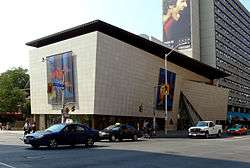 Bata Shoe Museum, (1991) Toronto, Ontario
Bata Shoe Museum, (1991) Toronto, Ontario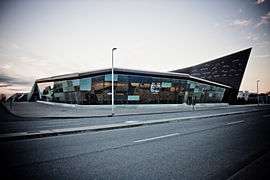 Canadian War Museum Ottawa (2005)
Canadian War Museum Ottawa (2005) Ottawa City Hall (1990)
Ottawa City Hall (1990)
 Toronto Reference Library (1973)
Toronto Reference Library (1973) Seneca@York Campus, Toronto (1999)
Seneca@York Campus, Toronto (1999)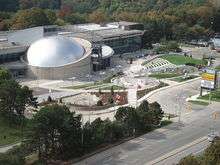 Ontario Science Centre, Toronto (1964)
Ontario Science Centre, Toronto (1964)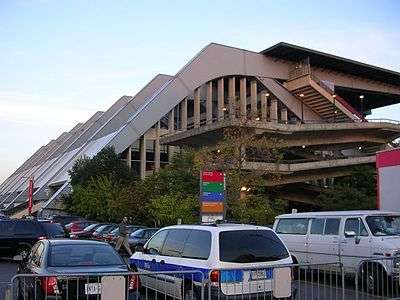 Ottawa Civic Centre (1968)
Ottawa Civic Centre (1968)- L'Amoreaux Collegiate Institute Scarborough, Ontario, (1973)
- Albert Campbell Collegiate Institute Scarborough, Ontario, (1976)
 John McCrae (Senior) Public School Scarborough, Ontario, (1969)
John McCrae (Senior) Public School Scarborough, Ontario, (1969)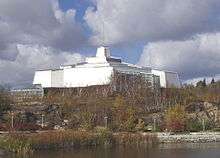 Science North in Sudbury, Ontario, (1980)
Science North in Sudbury, Ontario, (1980) Nova Scotia Community College Waterfront Campus (with Barrie and Langille Architects)
Nova Scotia Community College Waterfront Campus (with Barrie and Langille Architects)
- Toronto French School - new additions
.jpg)
References
- 1 2 Raymond Moriyama, Canadian Encyclopedia. Retrieved 3 April 2013.
- 1 2 3 "Architect Raymond Moriyama on internment: Canada's stories". Macleans.ca. 2014-05-03. Retrieved 2018-03-22.
- ↑ "The Architecture of a Life". U of T Magazine. Retrieved 21 January 2012.
- ↑ "The Architecture of a Life | Raymond Moriyama Architect, Canada World War Two, Japanese POW Camp | Winter 2018 | University of Toronto Magazine". magazine.utoronto.ca. Retrieved 2018-03-22.
- ↑ "Raymond Moriyama receives Award From Emperor of Japan". Canadian Architect. 2004-02-04. Retrieved 2018-03-22.
- ↑ "Canada Post Honours Moriyama | By Stacey Gibson | Canada Post Stamp of Ontario Science Centre, Raymond Moriyama Architect | Winter 2018 | University of Toronto Magazine". magazine.utoronto.ca. Retrieved 2018-03-22.
- ↑ "Prestigious new award for architecture endowed by Raymond Moriyama, FRAIC". Canadian Architect. 2012-06-25. Retrieved 2018-03-22.
- ↑ Emanuel Muriel (1980), "Contemporary Architects", Palgrave Macmillan. p563
External links
| Wikimedia Commons has media related to Raymond Moriyama. |
- Moriyama & Teshima Architects
- Raymond Moriyama fonds
- Moriyama and Teshima Architects fonds, Archives of Ontario
- Architectural Dialogues... / Dialogues architecturaux... Moriyama & Teshima, 2010, Archives of Ontario YouTube channel